$40K Showdown: Our Comparison Test of Six Sedans from 2013-2014

From the July 2013 Issue of Car and Driver
TESTED
Some people will undoubtedly argue that living to an advanced age means signing up for a slow agony if you must become a vegan or endure routine yogurt enemas to do it. Dr. John Harvey Kellogg famously disagreed. The co-inventor of Corn Flakes and a health nut a hundred years before Whole Foods sold its first kumquat, Kellogg made it to 91 preaching a steadfast diet of nuts and twigs and a watery lifestyle of sitz baths and regular colon cleansing. Victorian-era visitors to the good doctor’s enormous sanitarium in Battle Creek, Michigan, were presented with his lengthy list of items to avoid, including meat, seafood, eggs, milk, coffee, tea, mustard, vinegar, pepper, chocolate, tobacco, alcohol, iced drinks, “complicated meals,” stress, worry, and heavy clothing.
We might be inclined to add any near-$40,000 sedan that brings the heart rate down to a virtual standstill. That simply can’t be healthy. And yet such vehicles as the Toyota Avalon have been doing it for years. They persist for a generally older segment of buyers wanting big-car coddling in a plain brown wrapper, without all the pretension and assumed upcharging associated with a luxury nameplate.
Economics and two market oddities make our six-car test a surprisingly large one. The concertmaster is the Avalon, a sort of super Camry created to bridge the gap between Toyota and Lexus. Back in 1995, it proved that a front-drive mainstream mid-sizer could be pulled out, frosted with some chrome, and priced higher to yield more lucre. The Avalon is the fourth generation, it’s all-new, and, for the first time, it’s somewhat athletically shaped.
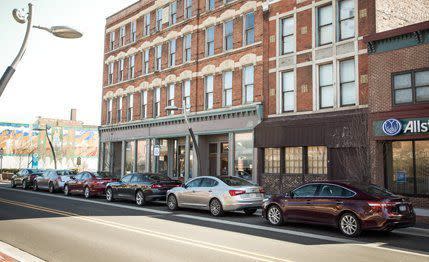
Where Toyota goes, Hyundai chases. The front-drive Azera is basically a ballooned Sonata, except that the new Azera has a 3.3-liter V-6 while Sonatas offer only four-cylinder engines. And where Hyundai goes, its sibling rival Kia inexorably follows. Kia’s own version of the Azera is the 2014 Cadenza, bearing entirely separate sheetmetal and interior treatments but with the same basic equipment and métier.
The home team is represented in part by the Chevrolet Impala, which qualifies for big-car status now that it rides on GM’s stretched Epsilon platform along with the Buick LaCrosse and Cadillac XTS. The two oddities here are also from Detroit. The Chrysler 300S and Dodge Charger SXT are both rear-drive, and neither one is derived from a smaller model.
In fact, present-day Chrysler has no credible seat at the mid-size-sedan feast, having left a hole between the Dodge Avenger and the Dodge Charger (and between the Chrysler 200 and 300) big enough to drive a quarter-million Honda Accords through. While Chrysler is attending to that problem, it is trying to squeeze the last drops of market mileage from the Charger and 300 by adding a new eight-speed automatic to the 3.6-liter V-6 spec sheet that promises better fuel economy. Conspicuous by its absence is the face-lifted Ford Taurus, mainly because the folks in Dearborn couldn’t find us one with a V-6 to test.
Do any of these relaxed-fit and middlebrow cars put us on the road to Wellville? We hit the trail to Battle Creek in search of an answer and an unforgettable yogurt enema.
Neighbors will notice when you drive home an Azera. As with a number of recent Hyundais, the car is a looker, with just enough muscular curve and exterior jewelry to stand apart in the commuting parade. Open the door and take a seat; the car’s design team has been eagerly awaiting this moment. Are you not impressed? We were. The dash looks like it has been upholstered with genuine robot skin, zooming you to the future with majestic sweeps of pseudo-metal and faux carbon fiber.
It’s clear that your $37,290, including $4000 for an extensive Technology package that lists a sunroof, buys a lot of features. The seat controls, mounted Mercedes-style on the doors, include a lower cushion extender for better thigh support. There are buttons to heat the leather-wrapped steering wheel, raise a sunshade over the rear glass, and fold in the mirrors (all of these are also in the Kia). It’s a layout that doesn’t assume you’re six feet tall, either. The dashtop is low, and the gauges and steering column point up from below, so outward visibility is excellent and a strong sense of command develops.
Nobody can accuse Hyundai of ignoring details, though we might have asked for a spin-tuning knob for the stereo, which would make leaping from satellite station 2 to station 122 much easier. The Azera’s seats are European-firm, supportive, and well shaped for long drives. Also, there’s no skimping on room in back, where passengers sink deeply into shaped bench pockets, and scallops carved into the headliner add precious headroom inches.
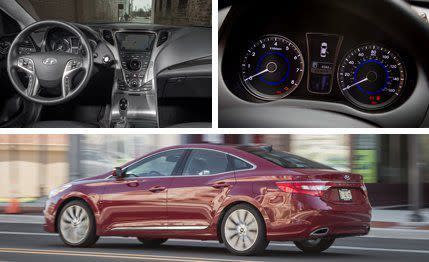
Everything about the Azera says “Yes!” That is, until you move the gear selector to “D.” It isn’t the fault of the engine and transmission, which work as close partners to create smooth, eager thrust. What lets down the Azera is its steering. Tuned too heavy, it feels leaden at low speeds, always jerking back to center with a peevish snap. And not enough body structure is asked to absorb the shock waves generated by too much damping resistance. The result is a continuous crash and reverb over the minutest of bumps. Call for the brakes, and the answer is weak.
Hyundais have been improving, but we have to keep saying this: The company can’t be taken seriously by our crowd until it fixes its driving experience.
Though it finishes near the back, the Cadenza’s 12-point lead over the Azera is substantial. Why? Don’t the two cars spring from the same seed? Indeed they do, but Kia chose a better path for its chassis, scrubbing the Hyundai’s dynamic mess down to just an annoying clutter.
For example, the suspension settings are softer, so every mile in a Cadenza isn’t a glaring reminder of the spot welds and structural bracing that are missing. And Kia opted for higher steering boost, which makes the Cadenza more pleasant to wheel around in daily use. True, if you throw it hard at an on-ramp, the wheel feels too light in your palms and you end up sawing the dead rim, looking for some sign of tire effort. Yet we prefer the Kia’s controls to the Hyundai’s, which is probably why the Cadenza was quickest through the slalom, even beating the Avalon. However, the Cadenza’s brakes lack commitment, as demonstrated by the longest stopping distance, and hard impacts still rattle the car’s relatively loose rafters.
Otherwise, as our editor-in-chief noted, the reason to choose the Kia over the Hyundai comes down to “whether you like straight lines or curvy lines.” The Kia’s horizontal styling is almost Volkswagen conservative, not surprising as Kia stole its chief designer and now company president, Peter Schreyer, from the VW Group. The 19-inch fine-spoke wheels fill their body cutouts fully, and the Cadenza, like the lesser Optima it’s based on, has a lovely stance. It looks substantial and luxurious from every angle.
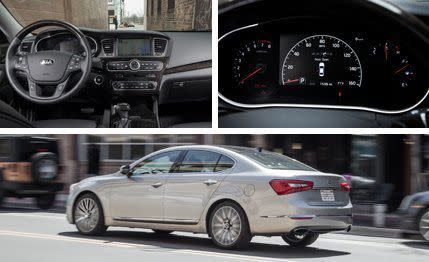
The linearity carries over to the interior. Unlike the supersonic Azera, the Cadenza is a law firm’s conference room inside, with orderly, straight rows of buttons set in generous slabs of a dark-gray trim meant to evoke wood. The optional computerized speedometer is a thin-film transistor (TFT) rendering that allows menu pagination and such graphic niceties as a ship’s compass. In our loaded-up example, you get an extra-large sunroof, radar cruise control, blind-spot detection, lane-departure alarms, heated and vented seats, and on and on. If $41,900 seems expensive for a Kia, know that some of these many baubles could be pruned without causing hardship.
Everything you touch feels classy, from the half-leather wheel to the precision gear selector. As in the Azera, the 3.3-liter V-6 is still vibration-free and sounding hearty at 6000 rpm as the transmission waits to execute its next seamless shift. In acceleration, both the Cadenza and the Azera landed near the quick end of the field.
Flaws notwithstanding, the Cadenza, our mileage champ at 25 mpg, is the perfect definition of “a nice car.” What this somewhat staid luxury sedan does for Kia’s supposedly youthful brand image, we’re not so sure, but it’s nothing terribly bad.
The car that made big sedans cool again continues to look like money, and a lot of intangibles get invoked when staffers talk about why they like the 300. It’s American, it’s rear-drive, and it sweeps into a parking lot like Al Pacino into a pizzeria: with purpose. If you’re going to buy a car on principle, this is the one.
As with the Charger, the 300 eschews a lot of design trinkets others use to imply luxury. There is no plastic woodwork inside, just fillets here and there marked by a gray cross-hatch pattern that hints at carbon fiber. Except for the art-deco dials and a few small slivers of chrome, the 300’s interior is mostly as black as a coal shaft. It is for people who prefer understatement, Brooks Brothers style. Well, except for the “Beats by Dr. Dre” stereo.
The S badge adds $3000 in extras, including the “touring” suspension, 20-inch wheels, some menacing black-chrome exterior treatments, and leather seats with rows of decorative white topstitching. A mere $115 at the bottom line separates this Chrysler from the Dodge, but you don’t get as many features in the 300. Among the Dodge items absent from the Chrysler are a sunroof, adjustable pedals, and power tilting and telescoping steering wheel, though this 300 does have radar cruise control.
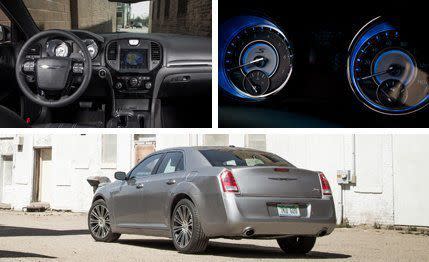
Befitting its role as a modern-day Imperial, the 300 isolates occupants from bumps with a more compliant chassis than the Charger’s. The brakes are the 300’s best dynamic attribute. A firm pedal triggers a pit bull’s bite on the discs. The 300 never feels small and lithe, but it can hustle a few corners with decisive grip and accurate, if completely cold, steering.
Yet the rear-drive doesn’t pay much dividend, despite the Chrysler twins posting test-best skidpad numbers. There’s plenty of understeer and body motion, and, as in the Charger, the eight-speed transmission does its business languidly, even in sport mode, as the V-6 works hard to keep the heavy mass moving. We could forgive the 300S for not being sporty if the rear seat felt any more spacious than a Corolla’s. And if the specially stitched and tufted seats were as comfortable as they are dandy-looking. They’re not, being rather lumpy and unsupportive.
The godfather Chrysler is getting old and will soon sleep with the fishes. We fear that whatever replaces it won’t have nearly as much personality. Until then, the 300 remains as an offer that isn’t so difficult to refuse.
Here’s one for people who refuse to age. Granola and prune juice? This car is for those planning to die with a Glock in one hand and a jalapeño double cheeseburger in the other. This is old school done as if there were never a new school.
Compared with the 300, the Charger is stiffer and sportier, with a little more zest to its directional changes and more crash in its suspension. It feels much too large to throw around, but it does move its tonnage, the test max at 4122 pounds, with controlled aplomb. What the V-6 lacks in Hemi punch, it makes up for in (somewhat) better fuel economy and reasonable refinement. The eight-speed automatic with its electronic T-bar selector is sophisticated German-car technology, though it sometimes feels a little slow to deliver the shifts.
Driving into the retirement home in a rear-drive ball-breaker with a spoiler on the trunk is an enchanting dream, but the reality does have warts. For starters, as with the 300S, there’s not much payoff for the rear-drive. The Charger has numb steering, and you need the Hemi if you want to roast the inherent understeer into a tasty drift. We expect rear-drivers to be automatically and radically better, but the superior-steering Avalon proves that there’s no immutable rule.
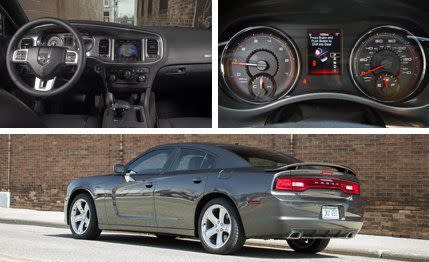
Also, you pay for rear-drive in interior space. Not necessarily in overall measurements, but in the way the transmission tunnel crowds the gas pedal and in the old-fashioned rear floor hump. The Charger’s seats were despised by all, mainly for the way the upper backrest falls away, leaving behind some fatiguing pressure points and a vacuum of support. And, as in the 300, the back seat is comically tight for such a large car.
Don’t wander into a Dodge showroom expecting the same Epicurean pampering that Kia and the others strive for. The Charger’s interior is a stark, dark cave of mostly hard plastics, though the giant snowplow blade pressed into the dash as decoration livens things up. However, many of the options packed into the $37,810 as-tested price, including blind-spot detector, a power tilting and telescoping wheel, power-adjustable pedals, and a sunroof, mean that the Charger scores well in features content.
You’ll always be young in the Charger, which is great as long as you don’t mind putting up with some inconveniences that didn’t bother you in your youth.
GM almost hits the big-car bull’s-eye with the Impala. Sure, there are things we would change, such as the interior, which, despite the 1001 ideas thrown at the dash, still manages to seem less than deluxe. Otherwise, the Chevy puts the pickle in the Wellville barrel with a spacious car that steams along quietly and smoothly and looks like a four-door Camaro.
GM assumes you want big iron because you need space. The Impala’s cathedral-sized trunk is the largest, at 19 cubic feet, and it’s accessed through a clamshell lid that looks like it’ll take a pair of skis sideways. The front interior volume is the largest in the test, and the folding rear seats (the Charger, 300, and Azera also have hinged rear backrests) don’t pinch, either, offering ample head and knee clearance.
The 3.6-liter V-6 purrs quietly and hits the high notes with a minimum of buzz, making for competitive acceleration times, albeit in a field where the 60-mph sprints are separated by only half a second. The pavement stickiness is solid, making for fast passage through corners, and, compared with the Korean twins, the Impala feels as solid as an S-class. The body soaks up pavement blows better than any car in this test, offering the best ride. But the Impala is no floater. It leans and pitches no more than necessary and feels tied down in fast twisties.
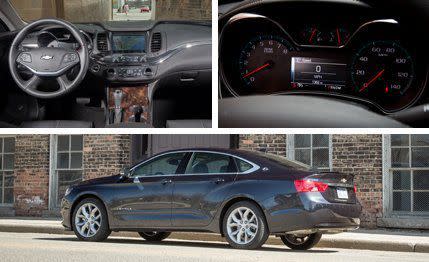
Two things we’d ask for are more steering feedback and better brake feel. The pedal pushes through a lot of sponge before finally finding brakes to engage. Perhaps this is why the forward-collision warning, a line of red LED lights on the dashtop, goes berserk at the merest hint of an approaching object (it’s part of the Advanced Safety package, or $890 you’ll spend to drive yourself crazy with alarms).
The 2LT trim amps up the luxury with ornamental topstitching across the dash and up the upholstery seams, which on the seats are also accented with bronze piping for good measure. On the dash, rings and dabs of chrome, inserts painted with gray metal-flake, and planks of burled woodlike plastic compete for your attention.
However, they can’t distract you from the yards of black blow-mold that drag the interior down to lower tax brackets. On the closed driver’s door, the arc of the trim line missed its counterpart on the dash by a quarter-inch, a wince-inducing mismatch. The touch-screen nav/info screen ($1095) is the latest version of Chevy’s MyLink system and proved a little fussier to program than the others. However, it motors up to reveal a USB port and a handy hideaway safe for valuables.
The Impala checks most of the boxes for this segment, and it is one likeable car, but others, especially the Koreans, put more love into their interiors.
Toyota has been in this game for a while, and it’s learned a few things. Like how to make a car with copious interior space, a rigid structure, and decent steering. These necessary elements all come together in the Avalon, which isn’t completely ugly. Finally.
While the Avvy is sprung too stiffly for being the old guy’s Toyota, it’s a suspension sophisticate compared with the Koreans. It takes the rough stuff with far less body shudder, damping out the audible tire slap to distant whumps. The alert steering is weighted just right between the too-soft Kia and the too-heavy Hyundai, with a more natural rise in effort as you bend the Avalon around a curve.
The dash looks like an architectural student’s final project. Overlapping surfaces create a deep three-dimensionality that is both fascinating and modern, though the chrome wings around the gauges remind us of horn-rimmed glasses. Radio and climate functions on the dished console are activated with touch-sensitive non-buttons that thump slightly in response to your touch. Divots near each button have been thoughtfully placed to guide fingers so eyes can stay on the road. Except for the fingerprint stains left on the textured surface, it works well.
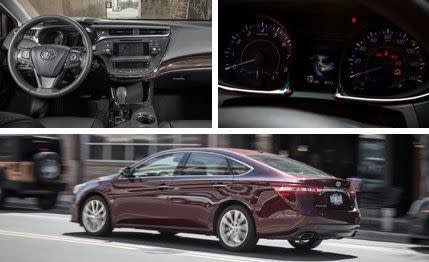
The navigation function is buried within the Entune system as an “app,” and, at 6.1 inches, the Avalon XLE’s screen is smaller than all of the others (at 8.4 inches, the 300S and Charger screens win the big-TV award). So keep your reading glasses handy. And the gear selector, which moves as if lubricated by sand, is a despicable exercise in cheapness, with a flimsy black-plastic skirt that will serve as a showcase for coffee spots and dandruff flakes. A few drivers also cited the seats for their hard, mostly flat bottom cushions that have strange misshapen mounds toward the rear.
Toyota is on a tear to make its cars more fun to drive. The test featherweight at 3521 pounds is also quick on its feet, posting the best quarter-mile acceleration and earning strong slalom and skidpad slips. The scores see-saw through this test. The Avalon joins the other Far Easterners, earning marks in the static categories of design and fit and finish, while the Detroiters do better in the dynamic categories. However, the Avalon is a shapely, gifted consensus builder, faring well in all the measures and best fulfilling Dr. Kellogg’s prescription for low stress in lightweight clothing.


('You Might Also Like',)

